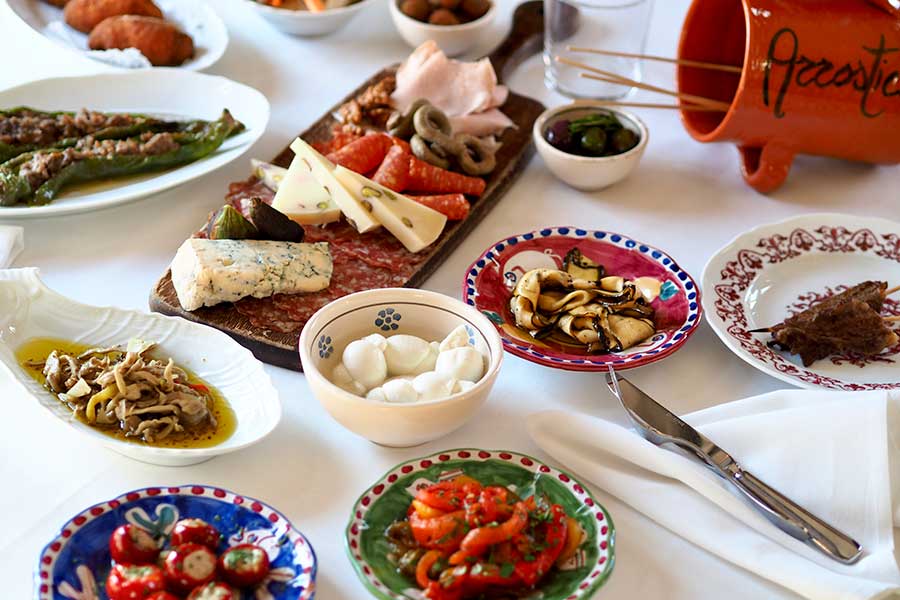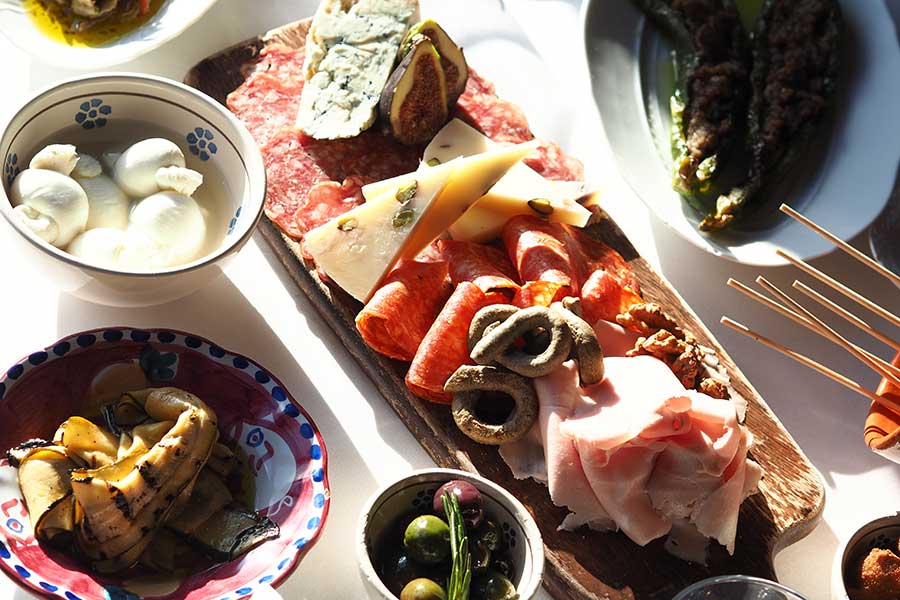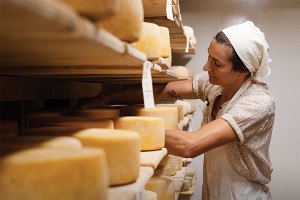How Cicala Created Philly’s Most Elaborate Antipasto
It's a menagerie of meats and cheeses, some of which Joe Cicala brought back from Italy in his suitcase.

The antipasto misto della casa at Cicala / Photography by Robyn Muse
Welcome to Just One Dish, a Foobooz series that looks at an outstanding item on a Philly restaurant’s menu — the story behind the dish, how it’s made, and why you should be going out of your way to try it.
Cicala at the Divine Lorraine is a restaurant that celebrates excess, and nothing on the menu exemplifies that commitment more than the antipasto misto della casa. The dish, which is in fact not a single dish but rather a tablescape of meats, cheeses, and bite-sized nibbles that come to the table in a never-ending parade, is a constant on the Cicala dinner menu, and one of the best eating experiences in town.
Priced at $24 per person, the spread always includes a charcuterie board with three salumi, a selection of fresh and aged cheeses, an assortment of marinated and pickled vegetables, and hot bites, like arancini, stuffed and fried olives, long hots stuffed with sausage, plus crackers, breads, and a few inevitable surprises.
“Part of the experience is that it’s kind of a joke, like you think they’re done putting things on the table and it just continues,” says Joe Cicala, the chef and co-owner of Cicala alongside Angela Ranalli-Cicala, who is also the restaurant’s pastry chef. When the restaurant first opened back in 2019, they offered a similar selection, but broken up à la carte, so people ordered just a charcuterie or cheese plate, and a side of other antipasti. Then, at a lunch while in Puglia, Joe and Angela ordered an antipasto misto for the table.
“I saw the parade of all the things that came to the tables,” Joe remembers. “And I was like, why don’t we just do this, instead of having people build their own, we’ll just make it an experience for them.” And so, their epic antipasto misto was born.

The antipasto at Cicala is an entire tablescape of meats, cheeses, and other accoutrements.
Since then, it’s become a staple of the menu, a generous portion of food for two or more people, perfect for lingering over with a bottle of wine. The number of dishes increases exponentially for larger parties. The aim, Joe says, is to always cover the table in little dishes, so for big parties of six or eight, they really get to go overboard.
It’s a little like a tasting menu for antipasti, with no two nights ever looking the same. The kitchen team varies the offering from day to day depending on market availability, other dishes on the menu, and even just Joe’s mood. They also use the antipasto misto as a testing ground for new dishes, an opportunity for line cooks to try out ideas in a smaller format, and a way to eliminate waste. The trim from a fish special might become a crudo for antipasto, while peak summer produce is pickled to serve in the dead of winter.
On a recent evening at Cicala, the antipasto experience included an unusual style of smoked prosciutto, brought back in a suitcase by Joe himself from a recent trip to Friuli, a northern region of Italy near the Slovenian-Austrian border. He’d visited the town of Sauris, a tiny town with a dedicated Protected Geographical Indication for this hyper-regional style of smoked prosciutto, which he tasted and immediately knew he wanted to serve at the restaurant.
The prosciutto was sliced to order in the middle of the dining room on the restaurant’s vintage deli slicer, then served immediately, paper thin and ready to be draped over bread, or simply devoured. That night, I also ate tender pieces of eggplant oreganata, lightly pickled overnight in vinegar and then seasoned with rich olive oil, oregano and garlic. There was a perfect ball of fresh burrata, olives stuffed with sausage and fried, and tiny pickled peppers, perfect for clearing my palette before returning for another bite. I shared that spread with two other people, and we followed it up with black truffle pasta and a rack of lamb. Next time, though, I’ll be dedicating my full attention to the antipasto.


